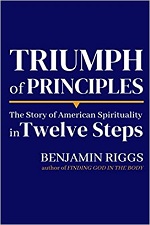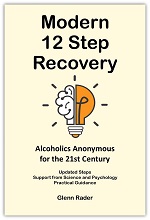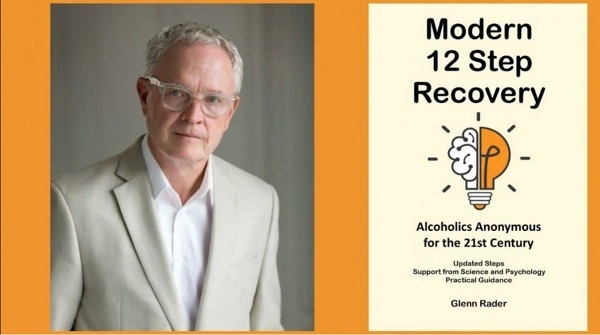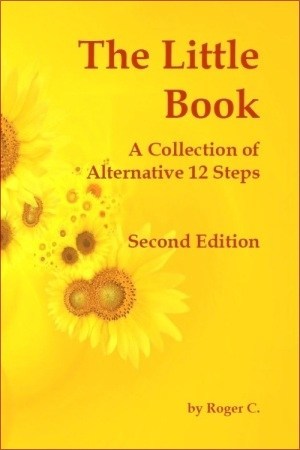A review by John B.
This book is a mixture of psychology, philosophy, U.S. History, and the history of AA. Even though the Twelve Steps are the primary focus of the book, the book is not primarily about AA. But, this is not a bait and switch, the author is explicit, his goal is to analyze the Twelve Steps as a, “complete system of spiritual practice,” useful to anyone who seeks spiritual growth. And he means anyone: atheist, agnostic, evangelical fundamentalist, Buddhist, literally anyone, the words of Bill Wilson can be used to build a solid spiritual foundation. The book can be described as a catalogue of personal interpretations of each of the steps with suggestions as to how the step can contribute to spiritual growth.
The book is a heavy duty read (397 pages), but don’t let that be a deal breaker. Each of the chapters can be read as a stand alone unit. Chapter titles like, “The Doctor’s Opinion”, “We Agnostics 2.0”, “The Oxford Group”, “Making Amends” and “Spiritual Maintenance”, might pique your interest.
As the title of the book implies, the author views the principles underlying the Twelve Steps as a distinctly American form of spirituality and he magnifies that thought by asserting that the Steps are America’s most significant contribution to the world of spirituality. He sees the Steps as a spiritual system useful to alcoholics and non-alcoholics and states without equivocation, “This book is intended for all spiritual seekers, not just those in recovery.” (p. 14)
Throughout the book the author attaches some interesting personal interpretations to the steps. Here’s one that caught my attention early in the book. “Contrary to popular belief, sobriety is not the primary objective of the Twelve Steps. The Steps aim to affect a spiritual awakening.” (p. 14) It’s hard to argue with that statement because Step 12 begins with, “Having had a spiritual awakening”. So yes, spiritual growth was a key part of Bill Wilson’s thinking. But I seriously doubt that without the benefit of an alcohol free nervous system any new recruit to 12 step recovery will achieve much spiritual growth.
Riggs is a serious thinker and his work provided me with a lot of food for thought. In his own unique way, the author presents the Steps as a significant chapter in U.S. History. He promises a “deep dive” into the Steps underlying principles and practices and points to our nation’s pluralism, religious liberty, and pragmatism as key variables. He sees the Steps as developing along two lines, religion and temperance. Those of you who have read the book, Not God by Ernest Kurtz might notice some similarities between Riggs’ writings and Kurtz’s references to Evangelical Pietism.
In the chapter “Religion and Temperance” Riggs sketches out a history of opposition to alcohol from colonial days all the way up to prohibition. He refers to a “second great awakening” which began at the end of the 1700’s and lasted up to the Civil War. This ending of the Age of Reason led to an explosion of religious intensity in the U.S. that focused on two sins, slavery and drunkenness. The War ended slavery; it didn’t end the thirst for booze. There was a frenzied opposition to the consumption of alcohol both socially and politically that coalesced to bring about the prohibition era from 1919 to 1933. According to Riggs, the main cause for this movement to lose its momentum was its view that drunkenness was a moral weakness.
AA offered an alternative to this line of thinking which brings us to Dr. William Silkworth who had a more appealing idea to present to the alcoholic and as it turned out to the general public. The author devotes 32 pages to “The Doctor’s Opinion” and how its underlying logic, its pragmatic foundation, made it an effective tool for combatting the feeling of powerlessness that afflicts every alcoholic. In the July, 1953, Grapevine, Bill Wilson wrote that Dr. Silkworth contributed “a very great idea without which AA could never have succeeded. (p. 39) Actually Wm. Silkworth wasn’t voicing anything new. The idea that alcoholism might be a sickness dates back to Dr. Benjamin Rush who wrote in 1784 that the effects of spirits could possibly be a problem of the mind and body. Rush was saying drunkenness was a sickness, a medical problem, not a moral problem. What Silkworth had to help promote that idea that Rush did not have back in 1784 was Jack Anderson and The Saturday Evening Post magazine. Anderson’s 1941 article gave AA a huge nationwide boost and Silkworth’s idea about alcohol as an allergy hitched a ride.
Riggs makes the point that the disease concept is useful even if the allergy claim doesn’t stand up to scientific scrutiny. It provided an easy-to-understand diagnosis that resonated with alcoholics and as an added bonus erased the stigmas of being weak willed and moral depraved. Interestingly, in a speech to the Springfield (Illinois) Temperance Society in 1842, Abraham Lincoln agreed with Dr. Rush: “In my judgement such of us as have never fallen victims [to alcohol], have been spared more from the absence of appetite, than from any mental or moral superiority over those who have.” – A purely intuitive reference to genetic predisposition that indicated empathy and foresight.
The author goes to great lengths (26 pages) to explain the importance of powerlessness in a person’s quest for spiritual growth. In this discussion he clearly separates himself from all the Big Book fundamentalists who worship “singleness of purpose” by stating “The Twelve Steps work for almost everyone because they are designed to remedy powerlessness, not alcoholism or drug addiction.” (p. 72) He gives a lengthy and somewhat sophisticated explanation of how the admission of powerlessness in Step 1 opens the door to a plan of action leading to spiritual improvement. I seriously doubt if Mr. Riggs would find much support for this view in traditional AA meetings. Personally, I doubt that many newcomers to AA show up at their first meeting seeking to enlarge their spiritual understanding.
Riggs makes the claim that AA, and consequently the Twelve Steps, never would have gained traction if not for the intense political fight over freedom of religion led by the likes of Thomas Jefferson and Benjamin Franklin. As he sees it this ongoing conflict created a diverse and pragmatic attitude towards religion where individual conscience prevailed over religious orthodoxy. This prevailing attitude created a climate where the AA compromise “as we understood Him” was generally acceptable.
Riggs, like many others, cites William James’ Varieties of Religious Experiences, as the source of much of Wilson’s thinking. He claims, “no one outside Wilson’s personal orbit contributed more to the development of the Twelve Steps than did James” (p. 112) Some might argue that the Oxford Group deserves serious consideration here. At any rate, the author contends that in 1938-39 our nation possessed a functional, pragmatic approach to religion, and he sees the Twelve Steps as a mirror image of that reality. No one size fits all, no theology, no dogma, in the steps gives us “a spiritual marketplace that emphasizes action, direct experience, and results over orthodoxy. From a purely historical perspective Riggs may be correct, but Jefferson, Franklin, James, and Wilson are no longer with us. Their words are on the pages, but my experience indicates that a Christian God dominates far too much of the AA “marketplace.”
Riggs combines pragmatism and open-mindedness to give every individual the latitude to view each step through the lease of their own conscience. He even builds a pragmatic view that the God of the Twelve Steps can be interpreted in such a way as to be useful to avowed atheists – if they are in pursuit of spiritual growth. He begins by offering a description of God from the famous mythologist Joseph Campbell: “God is a metaphor for all that transcends intellectual thought.” (p. 152) God can be seen as a kind of symbol and as Riggs sees it, “There is nothing in the Twelve Steps that says “God” is an obligatory symbol. Replacing it with Higher Power” or any other workable notion is certainly permissible” (p. 154) Basically, every individual is free to define God devoid of any metaphysics; God does not have to signify the existence of a supreme being. I admire the intellectual level of Riggs’ work on this topic, but many of us non-believers found a much simpler route to build a personal sense of spirituality. In my case, “as we understood Him” became “as I understand it”. From there I took off on a humanistic oriented path that led to spiritual growth based on quality personal relationships. The give and get of those relationships created a steady flow of spiritual growth.
Riggs’ breakdown of the Steps and his assessment of their spiritual value is far more complex than what is found in the Big Book. His analysis of Step 4 provides us with a good example of how he lays out his more expansive view. He stays close to Bill Wilson by suggesting the need to inventory three things – resentment, fear and sex – and then states that he “will utilize the format found in Alcoholics Anonymous”. I don’t know what definition of format Riggs relied on but the chapter “How It Works” in the Big Book goes from p. 58 to p.71; the analysis of Step 4 in his book goes from p. 212 to p. 259.
At the outset I stated that Mr. Riggs’ book is a mixture of psychology, philosophy, U.S. history, and the history of AA. It doesn’t get boring, bits and pieces pop up regularly. Just in the Step 4 analysis there are references to the Dalai Lama, Marcus Aurelius (stoicism), Emmet Fox (The Sermon on the Mount), Joseph Campbell (mythologist), Ralph Waldo Emerson (self-reliance & transcendentalism), and many, many times Bill Wilson. I don’t know where anyone could find a more detailed version of AA’s Twelve Steps.
Finally, I would put it this way: AA calls itself a design for living and Ben Riggs lays out a very intricate design. In his discussion of God and a Higher Power he makes a strong case for the agnostic position. Indeed, anyone struggling with how to fit into AA in spite of the God emphasis would get some sense of direction from The Triumph of Principles. I enjoyed the book.
The author of the review, John B, is an eighty-four year old sober alcoholic with 36 years of continuous sobriety. His alcoholism ultimately led to treatment, and eventually led to a career as an addiction counselor. John provided individual and group counseling to vets at the Marion, Indiana, V.A. hospital. He retired from the V.A. in 2001 and fondly describes it as the most challenging and satisfying job he ever had. John has also served as office manager for a major AA intergroup office in Ft. Wayne, Indiana for six and a half years. John reads 20 to 25 books a year, and three or four quality periodicals on a regular basis; mostly about politics, economics, science, history: about anything going on in the world that strikes his curiosity.
The post Triumph of Principles: The Story of American Spirituality in Twelve Steps first appeared on AA Agnostica.






